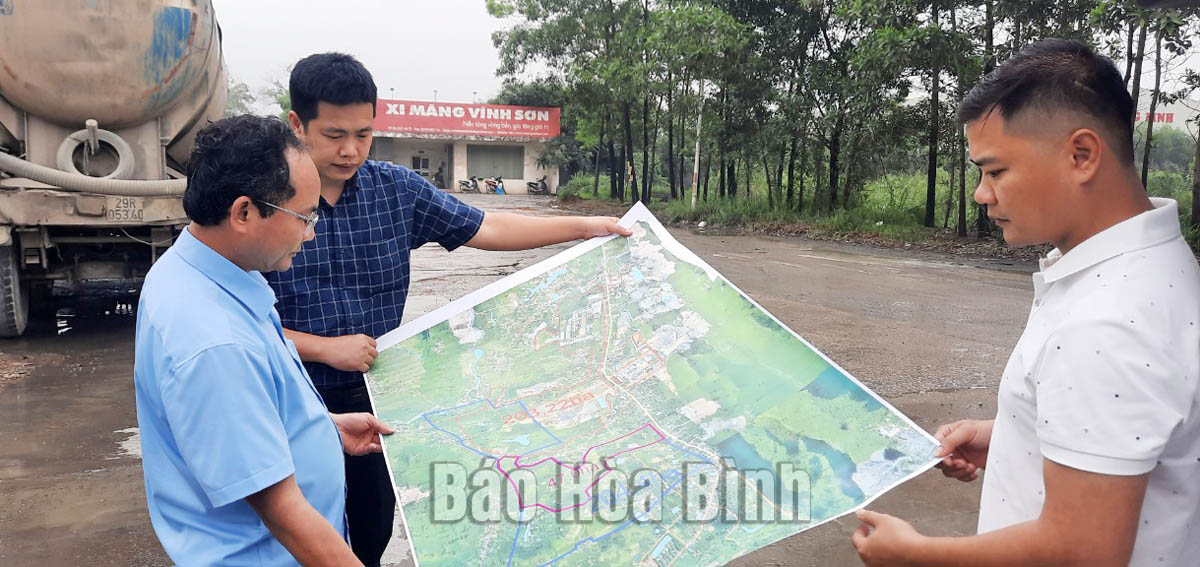
(HBO) – Luong Son district has many advantages when it has been determined as an economic driving force of the northern mountainous province of Hoa Binh with convenient transport infrastructure.
Over the past years, the district has focused on the planning
work, boosting administrative reform, improving the local business environment,
and mobilising resources to develop industrial infrastructure in order to
create sustainable economic restructuring.
Currently, the district has three industrial parks approved by
the Prime Minister, including Luong Son, Nhuan Trach, Nam Luong Son.

(Photo: Representatives of authorised agencies review the
planning work of Nam Luong Son industrial park)
The Luong Son Industrial Park has been invested in synchronous
infrastructure. The park has 43 registered and operating projects, including 16
foreign direct investment (FDI) projects, 27 domestic direct investment (DDI)
projects, helping to raise export value, contribute to the State’s budget and
create jobs for over 13,489 labourers of them over 9,000 are local workers. The
district is focusing on developing key industrial infrastructure.
Following the direction of the provincial People’s Committee,
the People’s Committee of Luong Son district has instructed divisions and
People’s Committee of communes to review investment potential in the locality
in an attempt to complete the province’s strategy on the development of industrial
zones and clusters to 2030, and at the same time integrate it into the
provincial master plan for the period of 2021 - 2030, with a vision to 2050.
Accordingly, the provincial People's Committee has proposed
supplementing the planning of two new industrial zones with a total area of
652.85 hectares, including Thanh Cao industrial park in Thanh Cao commune
covering 215.15 hectares and Tan Vinh industrial park in Tan Vinh commune with
an area of 437.7 hectares, bringing the total planned number of industrial
zones in the district to five industrial zones, with a total area of 1,153.73
hectares.
There are 84 projects in the district, of which five are FDI
projects, with total registered capital of nearly 34 million USD, and 79 DDI
projects with total registered capital of 13.93 trillion VND (589 million USD).
Deputy
Head of the district's Division of Infrastructure - Economic Affairs Nguyen
Hong Anh said in the first six months of 2023, the value of industrial,
handicraft and construction production is estimated at 48.81% of the yearly
plan (about 12.88 trillion VND), up 16.26% over the same period in 2022. The
province’s total export value was estimated to reach 335 million USD, reaching
45.9% of the yearly plan assigned by the district (730 million USD), up 32.2%
over the same period in 2022./.
According to data from the Hoa Binh Provincial Party Committee, the industrial production index for the first six months of 2025 is estimated to have increased by 20% compared to the same period last year. This marks the highest year-on-year growth rate for this period since 2020.
In the first six months of 2025, Hoa Binh province’s export turnover was estimated at 1.145 billion USD, marking an 18.11% increase compared to the same period in 2024. Import turnover was estimated at $ 804 million, a 17.15% increase, which helped the province maintain a positive trade balance.
The lives of the ethnic minority farmers in Tan Lac district have gradually improved thanks to the new directions in agricultural production. This is a testament to the collective strength fostered through the professional associations and groups implemented by various levels of the district’s Farmers’ Union.
With the motto the "product quality comes first,” after nearly one year of establishment and operation, Muong village’s Clean Food Agricultural and Commercial Cooperative, located in Cau Hamlet, Hung Son Commune (Kim Boi district), has launched reputable, high-quality agricultural products to the market that are well-received by consumers. The products such as Muong village’s pork sausage, salt-cured chicken, and salt-cured pork hocks have gradually carved out a place in the market and they are on the path to obtaining the OCOP certification.
In the past, the phrase "bumper harvest, rock-bottom prices" was a familiar refrain for Vietnamese farmers engaged in fragmented, small-scale agriculture. But today, a new spirit is emerging across rural areas of Hoa Binh province - one of collaboration, organisation, and collective economic models that provide a stable foundation for production.
Maintaining growing area codes and packing facility codes in accordance with regulations is a mandatory requirement for agricultural products to be eligible for export. Recently, the Department of Agriculture and Environment of Hoa Binh province has intensified technical supervision of designated farming areas and packing facilities to safeguard the "green passport" that enables its products to access international markets.



